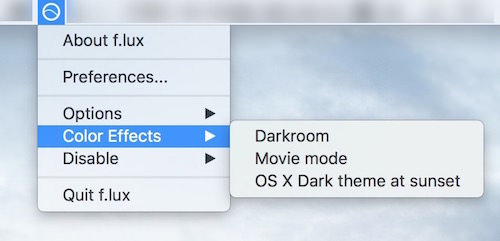 The experimental research suggests that an average person reading on a tablet for a couple hours before bedtime may find that their sleep is delayed by about an hour.
The experimental research suggests that an average person reading on a tablet for a couple hours before bedtime may find that their sleep is delayed by about an hour.
Install f.lux
f.lux fixes this: it makes the color of your computer’s display adapt to the time of day, warm at night and like sunlight during the day.

f.lux is free to use, available for Mac, Windows, Linux , and iPhone/iPad
To install official f.lux app on an iPhone/iPad, the device needs to be jailbroken. Why?
UPDATE: Apple operating system iOS 9.3 includes “Night Shift” mode, which is basically inbuilt f.lux. You can check the compatibility of you device here.
f.lux settings can be temporarily bypassed when watching a movie on your laptop.
How Blue Light Affects Your Sleep
The science that explains why blue light keeps you up was begun many years ago, and it continued in humans with the discovery of a new photoreceptor in the eye, called Melanopsin. Many are familiar with the “rods and cones” that provide our visual capabilities, but it was only about 15 years ago that retinal ganglion cells containing melanopsin, which are sensitive to a broad range of blue-green light around 480nm, were discovered, and their unique effect on sleep was investigated.
Read more: Blue light research papers
In Eyes, a Clock Calibrated by Wavelengths of Light
cites work by Cajochen et al in the May issue of The Journal of Applied Physiology.
Christian Cajochen did the first work we know of that uses real LED displays and measures them against older computer monitors. Many studies before this used light sources that you could believe were “like” these newer displays, but this paper tests the exact kind of backlight that we all use many hours a day.
Blue Light
David C. Holzman does a survey paper on the effects of blue light, with citations as early as 1958.
What’s in a Color? The Unique Human Health Effects of Blue Light Holzman DC 2010. What’s in a Color? The Unique Human Health Effects of Blue Light. Environ Health Perspect 118:A22-A27. doi:10.1289/ehp.118-a22

Mental activation and sleep
Some EEG studies of color effect on the brain have been done. One of the earlier ones we found is cited here.
“…we surmise that the effect of color temperature is greater than that of illuminance in an ordinary residential bedroom or similar environment where a lowering of physiological activity is desirable, and we therefore find the use of low color temperature illumination more important than the reduction of illuminance. Subjective drowsiness results also indicate that reduction of illuminance without reduction of color temperature should be avoided.”
These results suggest that low color temperature light creates a smooth lowering of central nervous system activity, and that low color temperature illumination can be used effectively in a bedroom or other such environment where it is desirable to facilitate lowered physiological activity.

 Slovenian
Slovenian